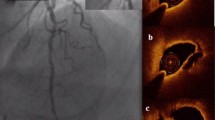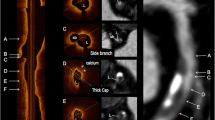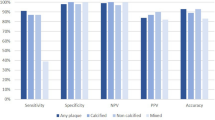Abstract
To evaluate the diagnostic efficacy of CCTA + plain scan for ruptured plaques, with optical coherence tomography (OCT) as the reference, and to provide preliminary analysis of influential factors. Patients who underwent CCTA and OCT were retrospectively enrolled. The diagnostic standards for ruptured plaque on CCTA + plain scan were ulcer or intra-plaque dye penetration on CCTA, and a careful review of images from the plain scans to ensure areas of them were not calcification. The diagnosis of ruptured plaque was made by OCT. Total 65 patients with 71 plaques were included. There were 40 OCT-confirmed ruptured plaques in 38 patients and 31 OCT-confirmed non-ruptured plaques in 27 patients. CCTA + plain scan identified 27 ruptured plaques in 27 patients and 28 non-ruptured plaques in 24 patients. With OCT as the gold standard, the per-patient sensitivity, specificity, positive and negative predictive values, and accuracy of CCTA + plain scan for diagnosing ruptured plaque were 71%, 89%, 90%, 69%, and 78%, and there was good agreement (Kappa = 0.70) between CCTA + plain scan and OCT. Among 13 false negative ruptured plaques, 2 had calcifications close to the rupture, and the cavity depth in the remaining 11 was 0.46 ± 0.17 mm, versus 0.98 ± 0.26 mm in 27 true positive ruptured plaques (P < 0.01). CCTA + plain scan may identify morphological features of ruptured plaques. The cavity depth of the ruptured plaques and calcification at the rupture site seem major factors influencing the diagnostic accuracy for plaque rupture. Future perspective studied are needed to confirm these preliminary findings.




Similar content being viewed by others
References
Virmani R, Burke AP, Farb A, Kolodgie FD (2006) Pathology of the vulnerable plaque. J Am Coll Cardiol 47:C13–C18. https://doi.org/10.1016/j.jacc.2005.10.065
Leopoulou M, Mistakidi VC, Oikonomou E, Latsios G, Papaioannou S, Deftereos S (2020) Acute coronary syndrome with non-ruptured plaques (NONRUPLA): novel ideas and perspectives. Curr Atheroscler Rep 22(6):1–8. https://doi.org/10.1007/s11883-020-00839-7
Leistner DM, Kränkel N, Meteva D, Abdelwahed YS, Seppelt C (2020) Stähli BE (2020) Differential immunological signature at the culprit site distinguishes acute coronary syndrome with intact from acute coronary syndrome with ruptured fibrous cap: results from the prospective translational OPTICO-ACS study. Eur Heart J 41(37):3549–3560. https://doi.org/10.1093/eurheartj/ehaa703
Hoshino M, Yonetsu T, Usui E et al (2019) Clinical significance of the presence or absence of lipid-rich plaque underneath intact fibrous cap plaque in acute coronary syndrome. J Am Heart Assoc 8(9):933–939. https://doi.org/10.1161/JAHA.118.011820
Jia H, Kubo T, Akasaka T et al (2018) Optical coherence tomography guidance in management of acute coronary syndrome caused by plaque erosion. Circ J 82:302–308. https://doi.org/10.1253/circj.CJ-17-1373
Kubo T, Imanishi T, Takarada S et al (2007) Assessment of culprit lesion morphology in acute myocardial infarction: ability of optical coherence tomography compared with intravascular ultrasound. J Am Coll Cardiol 50(10):933–939. https://doi.org/10.1016/j.jacc.2007.04.082
Tzolos E, McElhinney P, Williams MC et al (2020) Repeatability of quantitative pericoronary adipose tissue attenuation and coronary plaque burden from coronary CT angiography. J Cardiovasc Comput Tomogr S1934–5925(20):30130–30131. https://doi.org/10.1016/j.jcct.2020.03.007
Yuan M, Wu H, Li R et al (2020) The value of quantified plaque analysis by dual-source coronary CT angiography to detect vulnerable plaques: a comparison study with intravascular ultrasound. Quant Imaging Med Surg 10(3):668–677. https://doi.org/10.21037/qims.2020.01.13
Ravi KM, Andrews J, Kataoka Y et al (2019) Serial coronary plaque assessment using computed tomography coronary angiography. Circ Cardiovasc Imaging 12(3):e008404. https://doi.org/10.1161/CIRCIMAGING.118.008404
Hoogen IJ, Gianni U, Alawamlh OAH et al (2020) What atherosclerosis findings can CT see in sudden coronary death: plaque rupture versus plaque erosion. J Cardiovasc Comput Tomogr 14(3):214–218. https://doi.org/10.1016/j.jcct.2019.07.005
Madder RD, Chinnaiyan KM, Marandici AM et al (2011) Features of disrupted plaques by coronary computed tomographic angiography correlates with invasively proven complex lesions. Circ Cardiovasc Imaging 4(2):105–113. https://doi.org/10.1161/CIRCIMAGING.110.957282
Bilolikar AN, Goldstein James A, Madder Ryan D et al (2016) Plaque disruption by coronary computed tomographic angiography in stable patients vs. acute coronary syndrome: a feasibility study. Eur Heart J Cardiovasc Imaging 17(3):247–259. https://doi.org/10.1093/ehjci/jev281
Obaid DR, Calvert PA, Adam B et al (2017) Coronary CT angiography features of ruptured and high-risk atherosclerotic plaques: correlation with intra-vascular ultrasound. J Cardiovasc Comput Tomogr 11(6):455–461. https://doi.org/10.1016/j.jcct.2017.09.001
Yu M, Li W, Lu Z et al (2018) Quantitative baseline CT plaque characterization of unrevascularized non-culprit intermediate coronary stenosis predicts lesion volume progression and long-term prognosis: a serial CT follow-up study. Int J Cardiol 264:181–186. https://doi.org/10.1016/j.ijcard.2018.03.021
Kim U, Leipsic JA, Sellers SL et al (2018) Natural history of diabetic coronary atherosclerosis by quantitative measurement of serial coronary computed tomographic angiography: results of the PARADIGM Study. JACC Cardiovasc Imaging 11(10):1461–1771. https://doi.org/10.1016/j.jcmg.2018.04.009
Ando H, Amano T, Matsubara T et al (2011) Comparison of tissue characteristics between acute coronary syndrome and stable angina pectoris: an integrated backscatter intravascular ultrasound analysis of culprit and non-culprit lesions. Circ J 75:383–390. https://doi.org/10.1253/circj.cj-10-0815
Ohashi H, Ando H, Takashima H et al (2019) Diagnostic performance of high-resolution intravascular ultrasound for the detection of plaque rupture in patients with acute coronary syndrome. Circ J 83(12):2505–2511. https://doi.org/10.1253/circj.CJ-19-0644
Funding
Not applicable.
Author information
Authors and Affiliations
Contributions
CJ and DY conceived the study. ZW and XL helped to gather and interpreted all of the clinical data, as well as some of the pictures. YD, WW and HZ did data and statistical analysis. YY and WW were the writers of this document and revised the entire paper. CJ reviewed the final version of this paper and ensures that this study has been reported honestly, accurately and transparently.
Corresponding author
Ethics declarations
Conflict of interest
The authors declare that they have no conflict of interest.
Ethical approval
The content of this study was approved by the Ethics Committee of the First Affiliated Hospital of Dalian Medical University, and consent was waived in view of the retrospective nature of the study and the routine nature of all of the included procedures.
Informed consent
In view of the retrospective nature of this study and the routine nature of all of the procedures, written informed consent for inclusion in this study was waived.
Additional information
Publisher's Note
Springer Nature remains neutral with regard to jurisdictional claims in published maps and institutional affiliations.
Rights and permissions
About this article
Cite this article
Wang, Zq., Zhang, Hx., Wu, W. et al. Combined coronary CT angiography with plain scan for diagnosis of ruptured plaque: comparison with optical coherence tomography. Int J Cardiovasc Imaging 37, 3073–3080 (2021). https://doi.org/10.1007/s10554-021-02253-9
Received:
Accepted:
Published:
Issue Date:
DOI: https://doi.org/10.1007/s10554-021-02253-9




